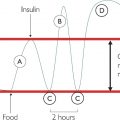9
Transfusion testing
As blood transfusion involves the transfer of either whole blood or specific blood products between patients, certain screening tests need to be conducted. It may also be appropriate to screen patients’ blood to ascertain their blood group or rhesus (Rh) status in case they subsequently require an intervention. Haematology and biochemistry are closely related areas so blood samples for transfusion or blood products might be requested at the same time. Typical tests would include ABO group and Rh type, blood group antibodies, syphilis, HIV and HepB.
The ABO blood group is determined by surface antigens and corresponding antibodies. In A group, the red cell has A antigens and thus anti-B antibodies in the plasma, as the presence of a red blood cell with a B antigen would suggest a foreign or exogenous source. In B group, the red cell has B surface antigens and thus anti-A antibodies in the plasma. For this reason, A blood cannot usually be given to B blood patients. In AB blood group, the red cell has both A and B surface antigens and therefore has no antibodies in the blood. Hence, a person with AB can usually receive any blood group. In O blood group, the red cell has no surface antigens but usually has both A and B antibodies. Hence, O can usually be given to all groups. As the plasma and red cells contain opposing antigens and antibodies, plasma compatibility is usually the opposite of red cell compatibility.
Rh type denotes the presence or absence of a D antigen, with Rhesus positive (Rh+) having the D antigen present. The Rh type is identified in addition to the antigen status of the red blood cell, for example, O- or AB+. People who are Rhesus negative (Rh-) can usually receive blood from matched ABO Rh- type, whereas Rh+ patients can usually receive either Rh- or Rh+ type.
Whole blood products can also be separated into their component parts: packed red cells from which most of the liquid component (plasma) has been removed; plasma; platelets; and fresh frozen plasma (FFP), plasma that is rapidly frozen which helps to retain key clotting factors.
Hepatitis screening for HepB (HBV) is usually done by checking for the HBsAg or HBcAb, the former being the surface antigen and the latter being the antibody. Some departments may offer the nucleic acid test, which determines the presence of HepB viral RNA. If the patient has an active infection then they are likely to have the antigen and/or the RNA, as well as the antibody (which may take a few weeks to develop). Hepatitis C (HBC) is usually tested by the presence of the HBC antibody.
Storytelling: Thinking about the A blood group in the ABO system, the white cells are your ‘protective army’ who will destroy foreign invaders. If you clearly mark your red blood cells with a red flag (A Ag), your army will NOT destroy cells with a red flag. But it WILL destroy cells with a blue flag, using its special anti-blue flag rockets (the anti-B Ab). You can therefore give your blood to other people with red-flagged cells, but not to people with anti-red flag rockets. AB people have red cells with BOTH red and blue flags, so they have NO anti-red or anti-blue rockets and can receive any type of red cell. In O group blood, the red cell has NO flags. O group blood can therefore be given to people in any group, even if they have anti-red or or anti-blue flag rockets. People with O blood can therefore usually only receive type O blood. Hence, type O blood is often referred to as ‘universal donor’, while type AB blood is a ‘universal receiver’.
Stay updated, free articles. Join our Telegram channel

Full access? Get Clinical Tree




